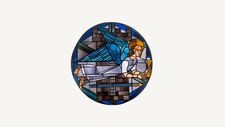
Cratered Landscapes
Soon after North Rhine-Westphalia was founded, lignite or brown coal gained in prominence to become the most important source of energy. Demand grew quickly in the energy hungry economic miracle years, when the cost of mining hard coal underground rose. Large-scale open-cast mines thus emerged in the Rhinish mining area. Enormous bucket-wheel excavators were deployed to move massive quantities of slag and lignite.
The excavators tear inexorably through the countryside. Rivers, villages and even churches have to make way for open cast lignite mining. The loss of homeland hurts. In 2018, the Church of St. Lambertus in Erkelenz-Immerath, fondly known by locals as the “Immerath Cathedral”, was demolished in spite of protests from the parish, citizens’ initiatives and conservationists.
It was possible to salvage this window from the side aisle. It had only been installed in 1980/81 by Cologne graphic designer and art professor Anton, known as Toni, Wolff. The stained glass shows an angel offering communion to Barbara, patron saint of miners. This rescued angel is a symbol of the homeland that was lost.
Today, the focus has been extended beyond the local consequences of open-cast lignite mining. The cratered landscapes have long since become a symbol of global climate change.